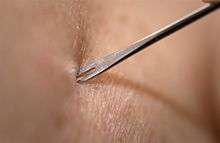Bifurcated needle

The bifurcated needle is a narrow steel rod, approximately 2.5 inches (6 cm) long with two prongs at one end. It was designed to hold one dose of reconstituted freeze-dried smallpox vaccine between its prongs. [1] Up to one hundred vaccinations can be given from one vial of the reconstituted vaccine. The established technique is to dip the needle in the vaccine, and then puncture a person's upper arm fifteen times in a small circular area. The most effective vaccination will result in a small drop of blood running down the vaccinated arm.[2]
Dr. Benjamin Rubin and Gus Chakros of Wyeth laboratories started development of the bifurcated needle in 1961 as a more efficient and cost effective alternative to the jet injector. It was the primary instrument used during the World Health Organization's smallpox eradication campaign from 1966 to 1977, which was spearheaded by Dr. D.A. Henderson. Rubin estimated that it was used to administer 200 million vaccinations per year during the final years of the campaign.[1]
References
Sources
- Tucker, Jonathan. Scourge. New York: Grove Press, 2001